Why You Should Never Just Toss Medications in the Trash
Keeping old pills in your medicine cabinet is risky. Kids find them. Pets chew through bottles. Someone else takes them by accident-or on purpose. The FDA says accidental poisoning from medications sends about 45,000 children under six to the emergency room every year. And more than 70,000 people die annually from prescription drug misuse. Most of these cases involve medications that were left lying around at home.
Even if you think your old antibiotics or painkillers are harmless, they don’t just disappear when you throw them in the trash. If they’re not handled right, chemicals from pills and liquids can leak into soil and groundwater. The EPA found that pharmaceuticals are present in 80% of U.S. waterways. That’s not just an environmental issue-it’s a public health one.
When Household Trash Is Your Only Option
Drug take-back programs are the best way to get rid of unused medications. There are over 14,600 collection sites across the country, including pharmacies like Walgreens and CVS. But if you live in a rural area, or there’s no drop-off nearby, you’re not out of luck. The FDA and EPA say it’s okay to dispose of most medications in your household trash-if you do it right.
Only 15 medications on the FDA’s Flush List should ever go down the toilet. These are mostly powerful opioids and sedatives that can be deadly if misused. If your medicine isn’t on that list, trash disposal is your safest choice.
The 5-Step Safe Disposal Process
Getting this right takes five simple steps. Skip any of them, and you’re risking safety and privacy.
- Check if your medication is on the FDA Flush List. If it is-fentanyl patches, oxycodone, buprenorphine, or others-you can flush it if no take-back option exists. Otherwise, skip flushing.
- Remove pills or liquids from their original bottles. Don’t throw away the bottle with your name and prescription number still visible. That’s a HIPAA violation waiting to happen.
- Mix the meds with something unappealing. Use used coffee grounds, cat litter, dirt, or even peanut butter. The goal is to make it look and smell gross. Use at least a 1:1 ratio-don’t just sprinkle a few pills into a half-full container. The FDA specifically warns against crushing pills or capsules. That can release dangerous dust you might accidentally breathe in.
- Seal it in a leak-proof container. A resealable plastic bag, an empty yogurt tub, or a small plastic container with a tight lid works. This keeps liquids from leaking and makes it harder for animals or people to dig through your trash.
- Hide your personal info. Use a permanent marker to black out your name, address, and prescription number on the empty bottle. Or wrap it in duct tape. Scratch it with a key. The point is to make it unreadable. Over 37% of improper disposal cases involve unobscured labels.
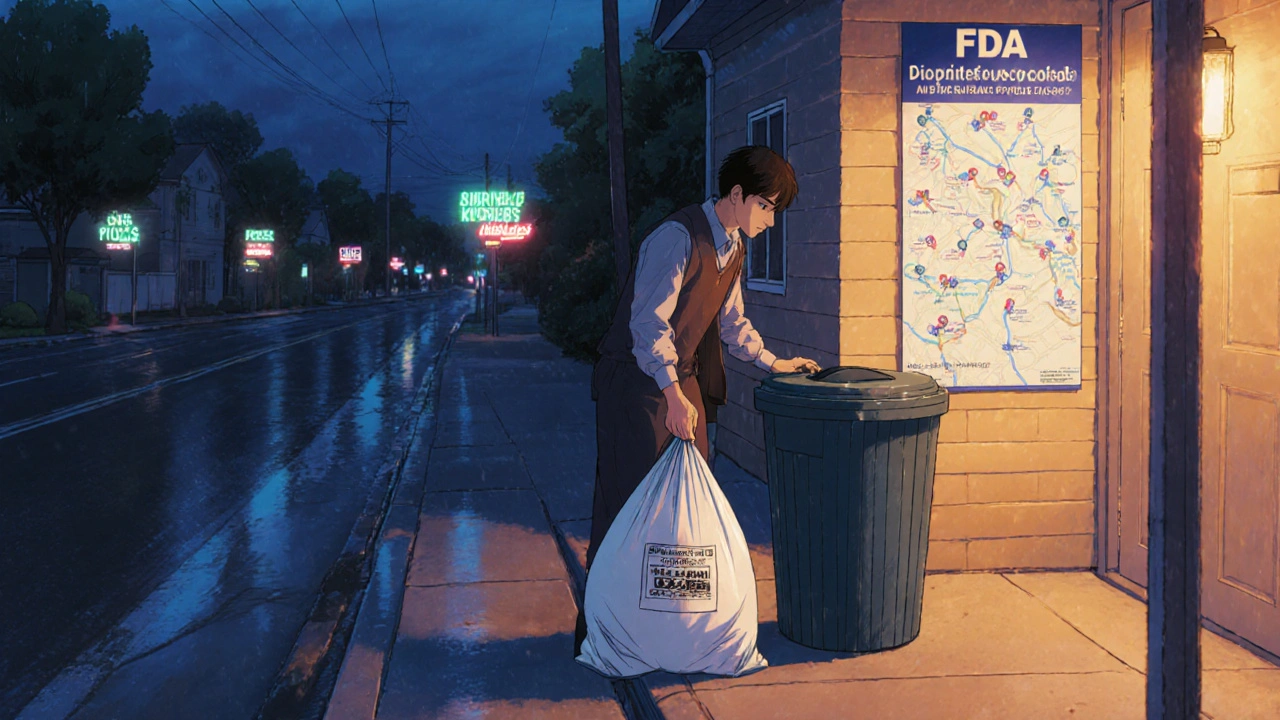
What Not to Do
Here are the most common mistakes people make-and why they matter.
- Don’t just dump pills in the trash. That’s how kids and pets get into them. Even a single pill can be fatal.
- Don’t use water to dissolve pills. It doesn’t work well, and it risks contaminating your sink or drain.
- Don’t recycle prescription bottles. Most #5 amber plastic bottles aren’t accepted by recycling programs. In fact, 87% of U.S. municipalities can’t process them. Throw them in the trash after removing labels.
- Don’t wait too long to dispose of meds. The longer they sit around, the higher the chance someone else finds them. Get rid of them within 24 hours of deciding to.
What About Liquid Medications?
Liquids are trickier. Pouring them down the sink is a bad idea. Here’s how to handle them:
- Don’t pour them into a cup or glass-spills happen.
- Use a syringe or dropper to transfer the liquid into a sealable bag.
- Add an absorbent material like kitty litter, sawdust, or paper towels to soak it up.
- Once soaked, seal the bag and place it in your trash container.
Some liquid medications come with disposal instructions on the label. Always check first.
State Laws Can Be Different
California has some of the strictest rules in the country. Under SB 212, which took effect in January 2024, every pharmacy with four or more locations must offer free medication disposal kiosks. And under California’s Medical Waste Management Program, no medication-no matter what-can go down the drain or into regular trash. That’s different from federal guidance, which allows trash disposal.
If you live in California, always use a take-back kiosk or mail-back envelope. Don’t rely on the FDA’s trash disposal advice. Other states may have similar rules. Check your state health department’s website if you’re unsure.
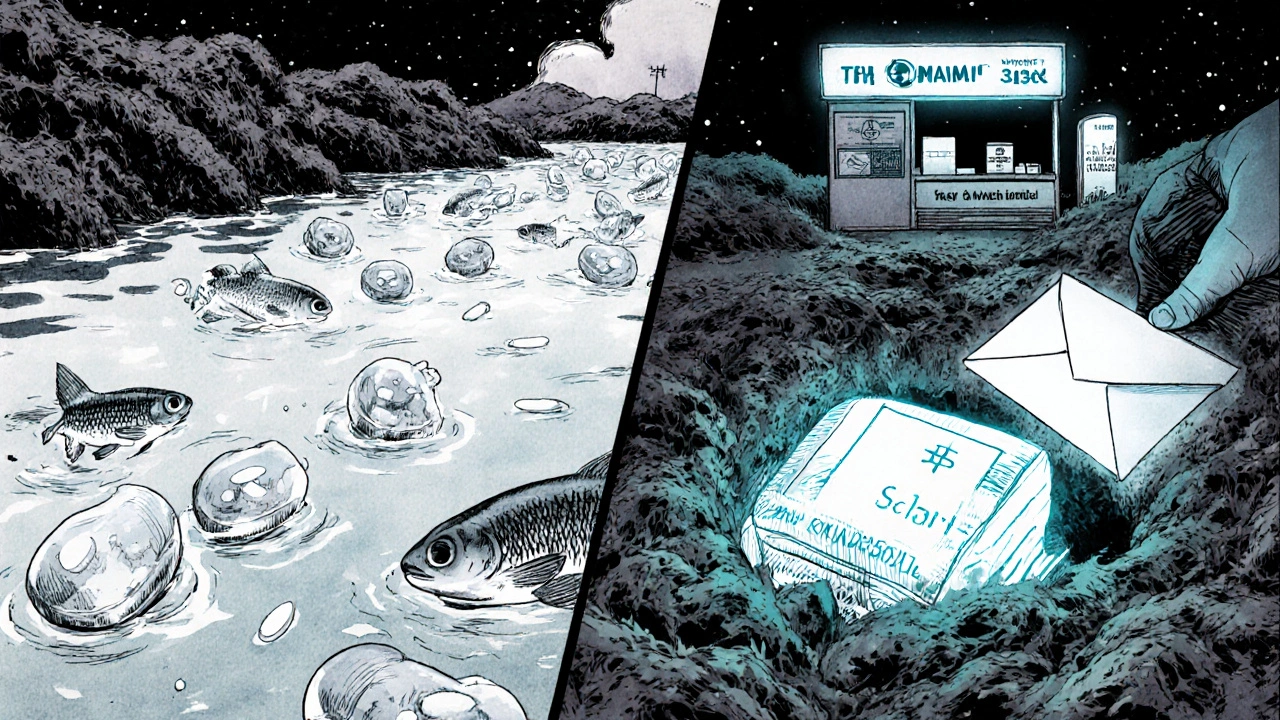
What’s Changing in 2025?
Things are improving. Since 2020, mail-back disposal envelopes have grown in popularity by 19% per year. Thanks to the Inflation Reduction Act, Medicare Part D now covers these services for over 65 million seniors.
The FDA is testing curbside medication pickup in 12 pilot communities. So far, they’ve collected over 8,400 pounds of unused drugs with 94% satisfaction from users.
And in the future, you might never have to worry about disposal at all. Three companies are testing water-soluble packaging that dissolves safely in your body-leaving no waste behind. Phase 3 trials are underway.
Still Not Sure? Here’s What to Do
If you’re confused, call the DEA at 1-800-882-9539. Or visit their website and use their online disposal locator. You can also ask your pharmacist-they’re trained to help.
Remember: The goal isn’t perfection. It’s safety. Even if you don’t do every step perfectly, doing some of it is better than nothing. Mix your meds with coffee grounds. Hide your name. Seal it up. You’ve just made your home-and your community-safer.
Why This Matters Beyond Your Home
Proper disposal isn’t just about protecting your kids or your pets. It’s about stopping the cycle of addiction, reducing pollution, and keeping our water clean. A 2023 study found that even when people follow all the rules, 12-18% of drug compounds still make it into landfill runoff. That’s why take-back programs are still the gold standard.
But when those aren’t available, you have power. You can choose to act responsibly. You can make sure your old pills don’t become someone else’s problem.
Can I flush any medication down the toilet?
Only 15 specific medications are on the FDA’s Flush List, mostly powerful opioids like fentanyl patches and oxycodone. Flushing other drugs can pollute water supplies. Always check the label or the FDA’s website before flushing. If your medicine isn’t on the list, don’t flush it.
What if I don’t have coffee grounds or cat litter?
You don’t need special products. Dirt, sawdust, powdered detergent, or even peanut butter work fine. The goal is to make the medication unappealing and unrecognizable. Use whatever you have on hand. The EPA confirms that common household items are just as effective as commercial disposal kits.
Can I recycle my old prescription bottles?
Almost always, no. The #5 amber plastic used for most prescription bottles isn’t accepted by 87% of U.S. recycling programs. Even if your local facility says yes, it’s safer to remove the label and throw the bottle in the trash. The risk of privacy breaches outweighs the recycling benefit.
Is it safe to crush pills before mixing them?
No. The FDA specifically advises against crushing pills or capsules. Doing so can release fine particles into the air, which you might accidentally inhale. Some medications are especially dangerous in powder form. Always keep pills whole and mix them as-is with an absorbent material.
What should I do if I live in California?
California prohibits disposing of any medication in household trash or down the drain. Use a pharmacy kiosk, a mail-back envelope, or a local drop-off event. Since January 2024, all pharmacies with four or more locations in California must offer free disposal kiosks. Don’t rely on federal guidelines-state law overrides them here.
How do I find a drug take-back location near me?
Visit the DEA’s website and use their disposal locator tool, or call 1-800-882-9539. Many pharmacies, hospitals, and police stations offer drop-off boxes. Walgreens, CVS, and other major chains have kiosks in over 1,500 locations. If you’re in a rural area, mail-back envelopes are a reliable alternative.

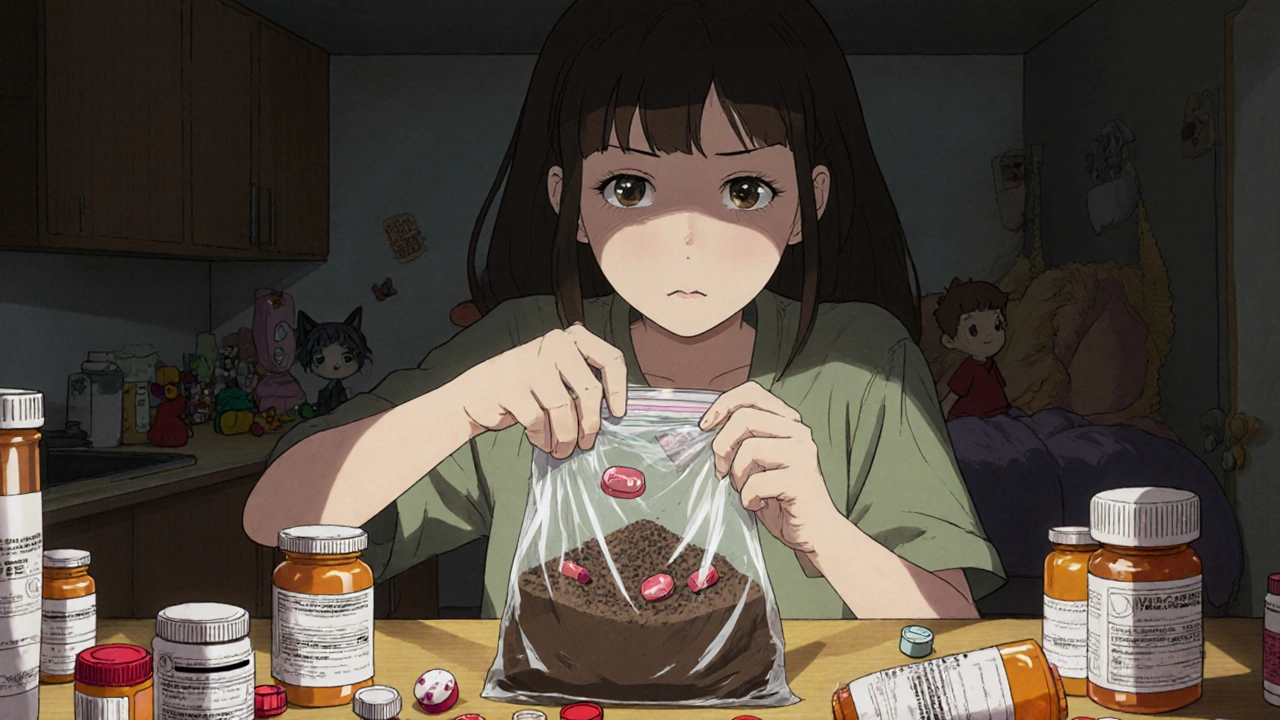

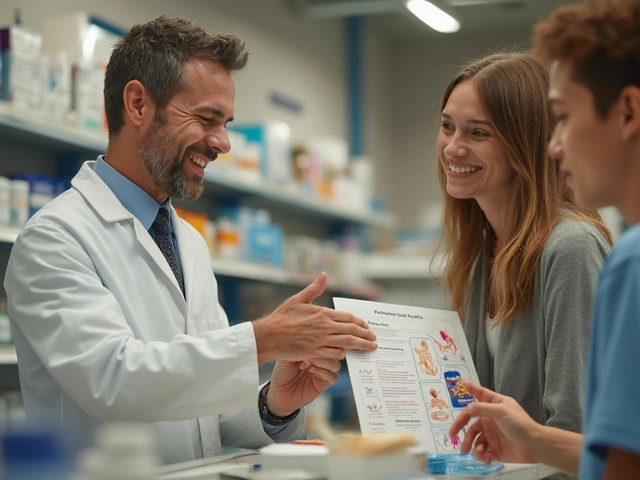
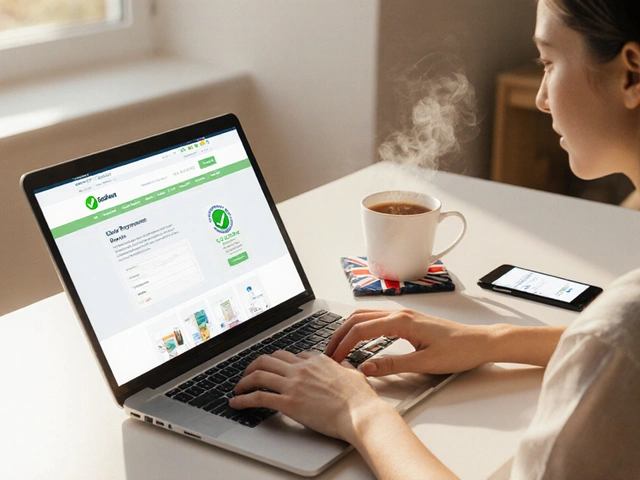
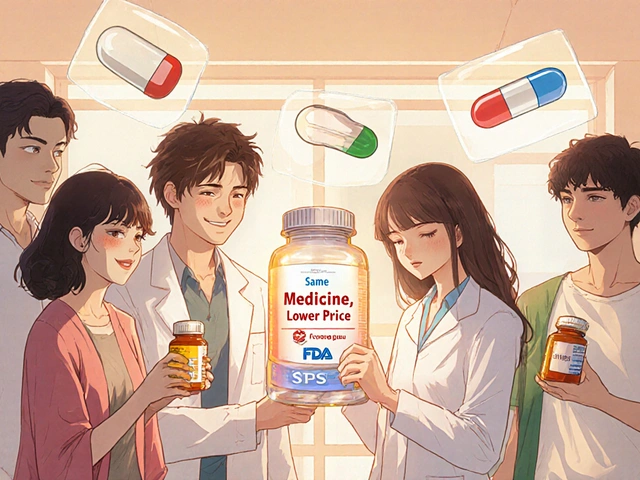
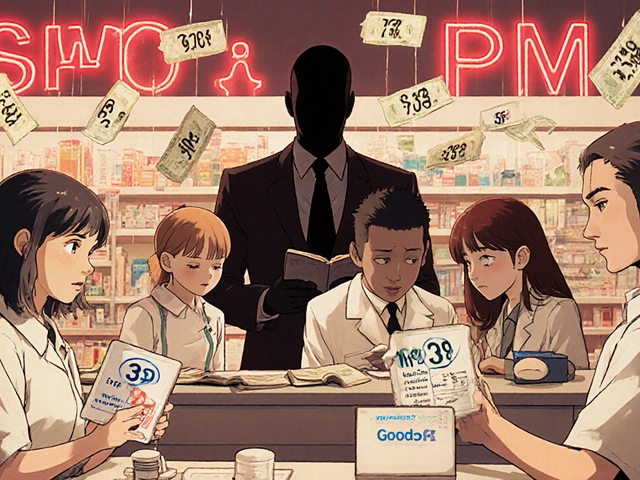
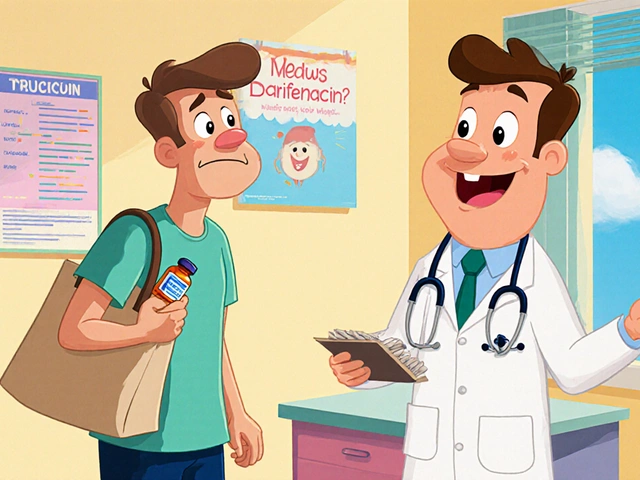
Esperanza Decor November 12, 2025
I never realized how many people just toss pills in the trash like it's nothing. This guide is a wake-up call. I'm going to start keeping a small container in my bathroom for old meds now. Mix with coffee grounds, seal it up, toss. Simple. And I'll be sure to black out the labels. No more risking my kid or the neighbors' dog.
Deepa Lakshminarasimhan November 13, 2025
They say this is safe but i think the gov is lying. The waterways are still full of drugs because they let us dump it. They don't want us to know the real reason they won't fix the system. They profit from the addiction. Look at the pharma companies. They're the ones pushing the pills in the first place. This 'safe disposal' is just a distraction.
Erica Cruz November 13, 2025
Honestly, this guide is laughably basic. If you're still relying on coffee grounds and yogurt containers in 2025, you're part of the problem. The real solution is systemic: universal take-back infrastructure, mandatory manufacturer take-back programs, and federal funding for rural access. This is band-aid advice for people who think 'doing something' is the same as 'doing it right.'
Johnson Abraham November 14, 2025
lol i just flush everything. who cares if the fish get high? also i dont black out labels cause im not a criminal. and yeah i crush the pills sometimes. its easier. if you dont like it then go live in a cave. 🤷♂️
Shante Ajadeen November 15, 2025
This is actually really helpful. I’ve been putting off cleaning out my medicine cabinet for months. Now I know exactly what to do. I’ll grab some cat litter tonight and get it done. Thanks for breaking it down so clearly - no fluff, just facts. Small steps matter.
dace yates November 15, 2025
Wait - if the FDA says it’s okay to use peanut butter, why do they still list only 15 drugs as flushable? Is peanut butter really safer than flushing? I feel like this is contradictory. What’s the science behind that?
Danae Miley November 17, 2025
The article correctly states that crushing pills is dangerous - yet the FDA’s own guidelines on their website mention 'crushing tablets' as an acceptable method for certain non-opioid medications. This post omits that nuance. You're misrepresenting the guidance by implying it's universally prohibited. Accuracy matters.
Charles Lewis November 18, 2025
It is important to recognize that the responsibility for pharmaceutical waste does not rest solely with the individual consumer. While the five-step method outlined here is commendable and practical for immediate use, the broader issue lies in the lack of standardized, accessible, and adequately funded national infrastructure for pharmaceutical take-back. We must advocate for policy reform that ensures equitable access to disposal mechanisms regardless of zip code, socioeconomic status, or geographic isolation. The current patchwork system is a moral failure disguised as personal responsibility.
Renee Ruth November 18, 2025
I just read this and I’m terrified. What if someone digs through my trash and finds my antidepressants? What if they think I’m weak? What if they steal them and sell them? I’m not even sure I can sleep tonight knowing my name was on that bottle. This isn’t just about safety - it’s about shame. And nobody talks about that part.
Samantha Wade November 20, 2025
This is exactly the kind of public education we need. Thank you for highlighting California’s stricter laws - too many people assume federal guidelines apply everywhere. And the fact that Medicare now covers mail-back envelopes? That’s a win. We need more of this. Not just for safety, but for dignity. People deserve to dispose of their medications without fear, stigma, or confusion.
Elizabeth Buján November 21, 2025
I think about how we treat our bodies and our waste. We’re taught to be clean, to be careful, to protect our health - but then we’re handed a bottle of pills that can kill someone and told to just throw it away. It’s weird. Like we’re being asked to be responsible in one breath and irresponsible in the next. Maybe the real problem isn’t how we dispose of them… but why we’re given so many in the first place.
Andrew Forthmuller November 21, 2025
just mix em with dirt and toss. done.
vanessa k November 23, 2025
I’ve been doing this wrong for years. I just threw the bottle in the recycling and dumped the pills in the trash. I feel awful now. I’m going to redo it tonight. I didn’t realize how much risk I was putting my neighbors in. Thanks for the reminder - we all need a little nudge sometimes.